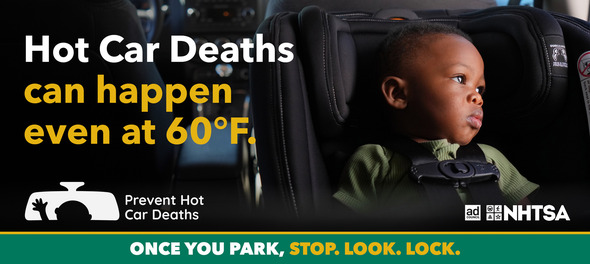Heatstroke is one of the leading causes of non-crash, vehicle-related deaths for children. Sadly, 1,010 children have died from heatstroke in a hot car since 1998.
Nearly every state in the United States has been affected by a pediatric vehicular heatstroke death. This tragedy is 100% preventable. While summertime is the peak season, heatstroke can occur in outdoor temperatures as low as 60 degrees.
Facts:
- Hot car deaths are the leading cause of non-crash, vehicle-related deaths for children 14 and younger.
- High body temperature can cause permanent injury or even death:
- More than 1,000 children have died due to pediatric vehicular heatstroke since 1998.
- 39 children died in 2024 because of vehicular heatstroke.
- On average, 37 children die per year due to vehicular heatstroke.
- In 2018 and 2019, we saw a record number of hot car deaths – 53 children died each year.
- The three main scenarios in which heatstroke occurs are:
- Children are forgotten in vehicles by parents or caregivers.Children gain access to unlocked vehicles and become trapped inside.
- Heatstroke begins when the core body temperature reaches approximately 104 degrees and the thermoregulatory system is overwhelmed. A core temperature of approximately 107 degrees is lethal.
- Children are more sensitive to heat than adults.
- Children are at a higher risk than adults of dying from heatstroke in a hot vehicle because their body temperature rises three to five times faster than an adult’s.
- The children most at-risk for heatstroke are those under 1 year, yet they make up one-third of hot car deaths.
- In 10 minutes, a car can heat up by as much as 20 degrees. Rolling down a window does little to keep a vehicle cool, even on a cooler day.
- Heatstroke fatalities have occurred even in vehicles parked in shaded areas and when the outside air temperatures were 80 degrees Fahrenheit or less.
- Summertime is the peak season for these tragic incidents, with children dying at an average rate of two per week. Unfortunately, hot car deaths can even occur in outdoor temperatures as low as 57 degrees. The warning signs of heatstroke vary, but may include:
- Red, hot, and moist or dry skin
- Absent sweating, even though the child is warm
- Strong rapid pulse or a slow weak pulse
- Throbbing headache
- Dizziness
- Nausea
- Confusion
- Grouchiness or strange behavior
How Does This Happen?
- The primary way a child dies from heatstroke is from a parent or caregiver “forgetting” their child in a vehicle. There are many factors at play, but a common one is a change in routine. Every family experiences a change in routine at some point, so every parent or caregiver is susceptible to this mistake.
- This “forgotten” circumstance accounts for more than half of the total child hot car deaths that have occurred since 1998. In approximately half of these “forgotten” deaths, specifically, the child was on their way to childcare or preschool. A busy parent or caregiver may unintentionally forget that a quiet or sleeping child is in the back of the vehicle. This most often occurs with children under one year of age. Always remember: Once You Park, Stop, Look, Lock. These actions could save a life.
- Toddlers and young children are also at risk, as they can climb into a vehicle without supervision. Children may be playing or hiding, but if they enter a vehicle without the knowledge of an adult, they may be unable to get out of the car, especially if child locks are activated. It is essential to teach children that cars are not a place to play. Parents and caregivers should get into the habit of storing keys and fobs out of a child’s reach.
- Sometimes, children are left intentionally by parents or caregivers who do not understand the dangers of a hot vehicle and may have a quick errand to run, or who may not understand how quickly a vehicle can heat up to deadly temperatures. It cannot be overstated: Never leave a child in a vehicle alone, not even for a minute.
- The day of the week may have an influence on children who have been forgotten in a vehicle, or who have gained access: “Forgotten” deaths are most likely to occur on Thursdays and Fridays, while deaths in which a child has unknowingly climbed into a vehicle typically occur on weekends, with Sunday being the most at-risk day.
- By the end of 2024, Texas and Florida had the highest number of child heatstroke deaths. Additional states at the highest risk for heatstroke deaths per capita are Alabama, Arkansas, Arizona, Kansas, Kentucky, Louisiana, Mississippi, Nevada, New Mexico, Oklahoma, South Carolina, and Tennessee.
Tips:
- NEVER leave a child in a vehicle unattended, not even for a minute.
- Make it a habit to check your entire vehicle, especially the back seat, EVERY time you exit the car.
- Always lock your car when you aren’t using it, and put the keys out of reach. Even if you don’t have a child of your own, a child in your neighborhood could get into your unlocked vehicle.
- Keep an item in the back seat, like a toy. Put the toy up front with you when your child is in the car seat to serve as a reminder. Or, put your purse or work bag in the back seat with the child.
- If you see a child in distress in a vehicle, act. Call 911 immediately and get help.
For more information, visit www.trafficsafetymarketing.gov/safety-topics/child-safety/vehicular-heatstroke-prevention.

